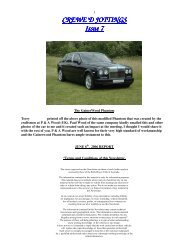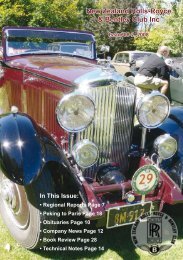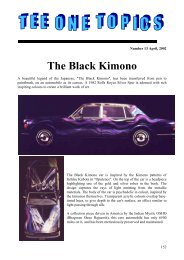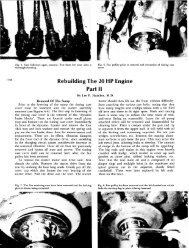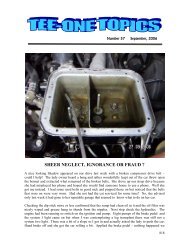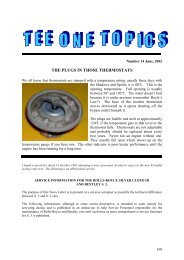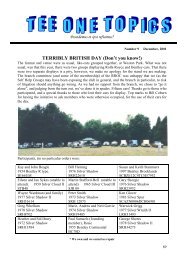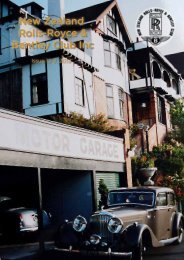Issue 34b - The Enthusiasts Website for Roll-Royce & Bentley Motor ...
Issue 34b - The Enthusiasts Website for Roll-Royce & Bentley Motor ...
Issue 34b - The Enthusiasts Website for Roll-Royce & Bentley Motor ...
Create successful ePaper yourself
Turn your PDF publications into a flip-book with our unique Google optimized e-Paper software.
joins and fold up the edges and corners to limit the flow of the paint remover. Upon completion<br />
the paper can be rolled up and placed in plastic bags.<br />
Pour the paint remover over the pieces and leave it to react. Unless the wood has been refinished<br />
using a non-polyester material nothing will happen very quickly so don't expect instant results.<br />
It helps to keep the pieces wetted either by tipping on more paint remover or by scooping the<br />
excess off the paper and putting it back on the wood but don't scrape or otherwise disturb the<br />
coating. Eventually the polyester will fragment and take on, <strong>for</strong> want of a better description, a<br />
sugary appearance. At this stage scrape the coating away with a soft scraper, the spreaders used<br />
<strong>for</strong> polyester body fillers are ideal. Ideally the coating will lift away easily and the paint remover<br />
will not even have penetrated through to the veneer. Too soon and either the coating will remain<br />
intact or only small areas will lift away and then with some ef<strong>for</strong>t. If this is the case just pour on<br />
more paint remover and wait.<br />
When the coating has been removed wash the pieces down with cellulose paint thinner to<br />
remove all traces of the paint remover. Any small fragments of lacquer can be picked off easily.<br />
Do this several times and do not be afraid to really wet the surface then leave everything to dry<br />
out.<br />
As an alternative you can use a hot air gun and a scraper but be warned that fragments of<br />
polyester will fly off and eye protection is essential. <strong>The</strong>re is also a very significant risk of<br />
scorching the surface with the resultant discolouration. In many thousands of pieces I have never<br />
encountered a problem using paint removers so I suggest sticking with this method. Try this<br />
with any Jaguar or Aston Martin wood trim from the same period however and the veneers will<br />
lift off, assuming this has not already happened.<br />
At this stage the surface will be rough, slightly shiny and fairly dark in colour. After picking off<br />
any small fragments with a small craft knife begin sanding the surface. I wouldn’t bother using<br />
glass paper as a conventional woodworker might but suggest instead using 3M pre-cut, or<br />
similar, abrasive paper, which you can buy from any supplier of vehicle, paints. European and<br />
American grading systems differ slightly and as I have no idea what system is used in Australia<br />
it would be a good idea to cross-reference the European grades I will quote. While you are at the<br />
paint supplier buy some spirit wipe, sometimes called pre cleaner. Painters use this to wipe<br />
down prior to spraying to remove any residual contaminants from fingerprints etc. A litre will be<br />
sufficient.<br />
When sanding it is essential to use a hard backing <strong>for</strong> the paper. If the backing has any give it<br />
will apply greater pressure on the edges and will have a tendency to wear through the veneer but<br />
even if this extreme is not reached any unevenness created will still have to levelled out by the<br />
clear coat later. I suggest starting with P120 used very lightly just to skim over the surface and<br />
break the slight glaze it will have at this stage be<strong>for</strong>e switching to P180. Make sure the paper is<br />
kept tightly against the backing. <strong>The</strong> paper will clog initially so wire brush it frequently or<br />
change to a new piece. Electrically operated orbital sanders can be used but care must be taken<br />
to avoid damage to edges as they are usually supplied with a soft sponge backing. When<br />
working around the instrument openings use a piece of 1” dowel or similar to back up the paper.<br />
Be very careful when working on the edges of the cross banding on the waist rails and<br />
companion sets, this will already have been well sanded during production. <strong>The</strong>re are techniques<br />
to repair it but the best solution is not to cause any damage in the first place. After blowing off<br />
any dust you will find the surface is smooth to the touch and free of any scratch marks. Final<br />
finishing with P240 will improve the finish still further. Ideally using a compressor and<br />
blowgun, remove all traces of dust.<br />
493



